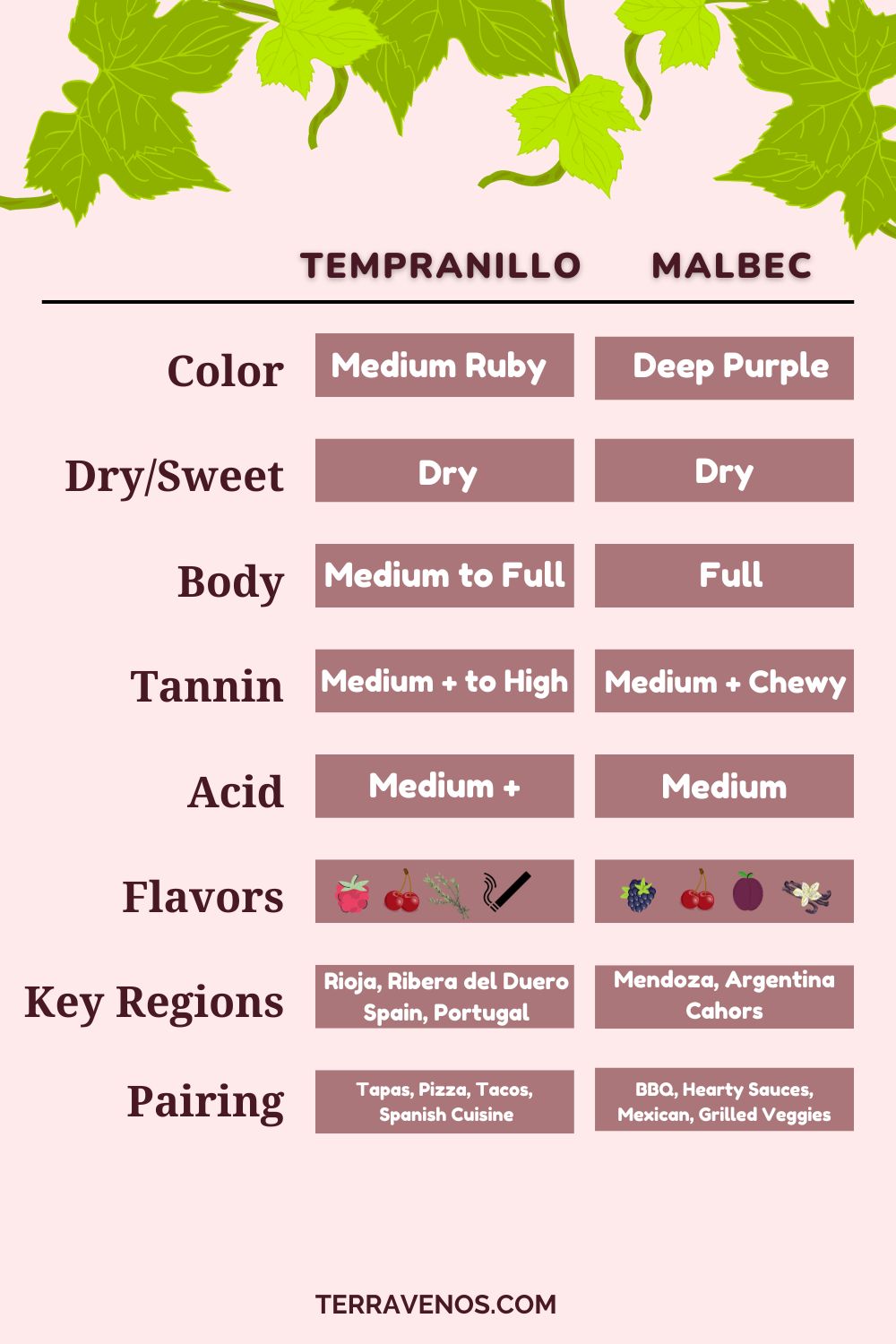
Tempranillo vs Malbec makes sense if you’re newer to wine and trying to sort through the many different styles.
Malbec has a medium to full body, rich flavor of plum and blueberry, and often a plush texture. Tempranillo has red fruit and savory notes. Both wines are widely available.
Comparing Tempranillo vs Malbec is a must-try side-by-side tasting for newer red wine enthusiasts. These are both popular red wines you’ll come across regularly.
Tempranillo Basics: Spain’s Red Wine
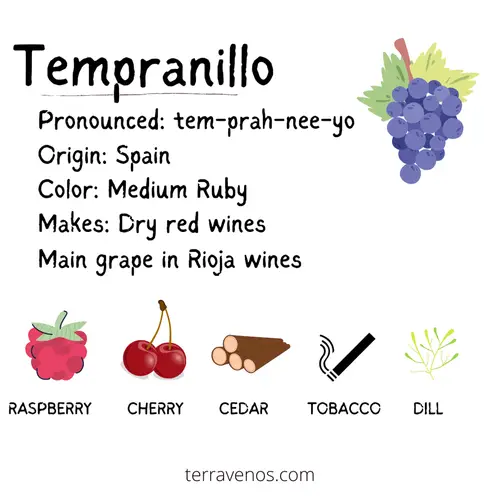
Tempranillo, a well-regarded grape originating from Spain, has gained worldwide recognition for its robust character. Now a global favorite, Tempranillo thrives in vineyards worldwide, from Spain’s Rioja and Ribera del Duero to New World regions.
With its deep crimson color, Tempranillo offers a palate of red berries complemented by subtle hints of vanilla and leather. This flavorful profile has made it popular among wine enthusiasts globally, securing its place in cellars.
Spain, the birthplace of Tempranillo, showcases its versatility from everyday wines to prestigious reserva and gran reserva selections.
Fun Wine Fact: Tempranillo gets its name from the Spanish word “temprano,” meaning early, as it usually ripens before many other grape varieties.
Helpful Tip: Here’s a complete guide to Tempranillo.

Malbec Basics: Argentine Elegance
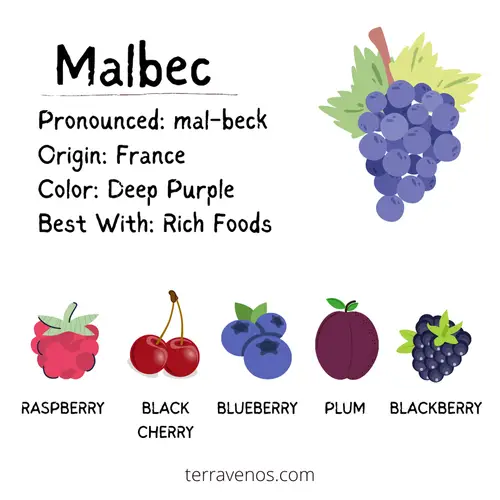
Malbec, a true Argentine wine, offers an accessible red wine experience. With its origins in France, Malbec is the most widely exported wine of Argentina. This grape variety showcases a distinct character with red and black fruit flavors and a lush, smooth mouthfeel. Malbec’s full body and flavors of ripe blackberries, plum, and sometimes a hint of vanilla pair wonderfully with grilled meats and hearty dishes.
Helpful Tip: Here’s a complete guide to Malbec wine.
Malbec is known for its medium to full body, providing a substantial weight on the palate. Its flavor profile, often influenced by the Argentine terroir, includes dark fruits and a unique richness.
Fun Wine Fact: Malbec gained significant popularity when it was introduced to Argentina in the 19th century. Today, Malbec has gained recognition beyond its Argentine origins, with vineyards in regions such as France, the United States, and Australia.
Wine Comparison: Malbec vs Tempranillo
Here’s a quick side-by-side comparison that covers the most common styles of Tempranillo and Malbec:
| Characteristics | Tempranillo | Malbec |
|---|---|---|
| Hue | Medium Ruby to Garnet | Deep purple to Ruby |
| Color | Red | Red |
| Aromas | Red berries, plum, tomato, coconut | Blackberry, plum, cocoa |
| Tannins | Medium to high | Medium to High |
| Acid | Medium to high | Medium |
| Alcohol (%) | 13-15% | 13.5-15% |
| Body | Medium to full | Full |
| Intensity | Moderate to pronounced | Pronounced |
| Key Growing Regions | Spain (Rioja), Argentina, Portugal | Argentina, France (Cahors) |
| Classic Pairings | Grilled meats, chorizo, tapas | Grilled steak, barbecue, hearty stews |
| Price Range | $10-$50 | $10-$40 |
Tempranillo Wine Profile
- Sweetness: Tempranillo is typically produced in a dry style, offering minimal residual sugar.
- Alcohol: Tempranillo wines generally have a low to moderate alcohol content, ranging from around 12% to 14% ABV.
- Body: Known for its medium to full body, the style of Tempranillo will depend on the growing region and winemaker.
- Tannins: Tempranillo has similar tannins to Malbec, in the medium to high range.
- Flavor and Aroma Intensity: Tempranillo has juicy red fruit, including cherry, plum, and tomato (tomato leaf); aged Tempranillo can get savory leather notes
- Flavors: The flavor profile often includes red cherry, strawberry, raspberry, with a touch of coconut and spices.
Malbec Wine Profile
- Sweetness: Malbec wines lean towards dryness, offering a range of dry to off-dry styles.
- Alcohol: Malbec wines typically have a moderate to high alcohol content, similar to Tempranillo, ranging from around 13% to 15% ABV.
- Body: Malbec is known for its medium to full body, offering a rich and satisfying drinking experience.
- Tannins: Malbec showcases moderate tannin levels, these often feel softer than Tempranillo’s tannins
- Flavor and Aroma Intensity: Malbec boasts intense dark fruit notes and a plush mouthfeel.
- Flavors: The flavor profile often includes plum, black cherry, cocoa, and sometimes a hint of vanilla.
Are Tempranillo and Malbec Similar?
Both Tempranillo and Malbec share a medium body and noticeable tannins. Tempranillo and Malbec often have similar alcohol levels.
What Is the Difference Between Tempranillo and Malbec?
Tempranillo is different than Malbec due to its bright red fruit, giving it a leaner feel in your mouth, compared to Malbec’s medium to full body.
Tempranillo vs. Malbec: Food Pairings and Serving Temperature
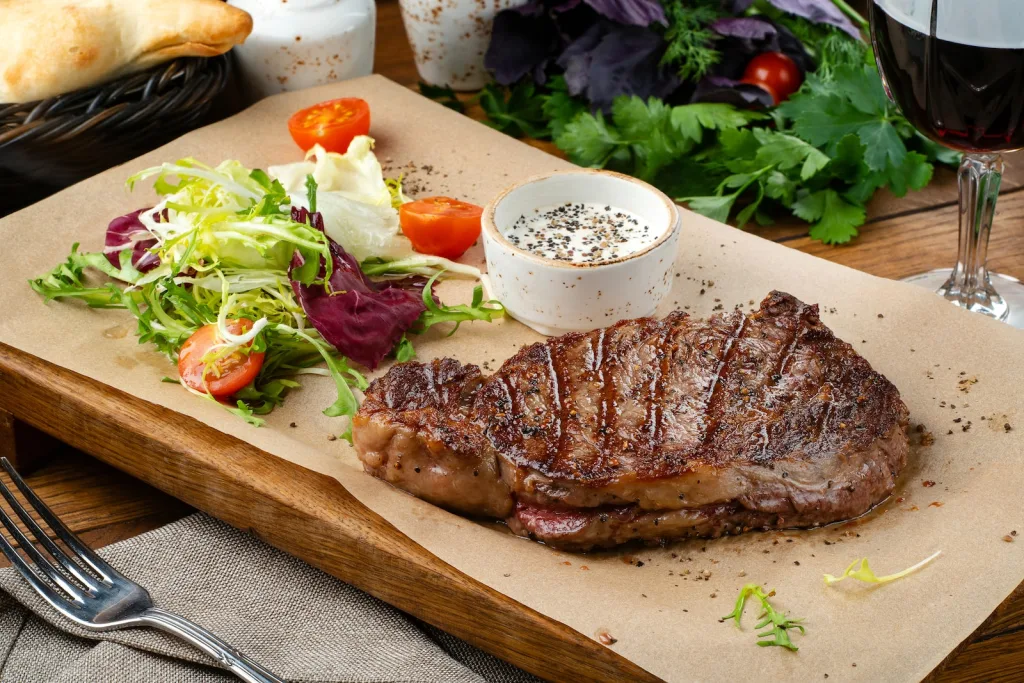
Tempranillo: Tempranillo’s bright red fruit profile makes it an excellent pairing partner for earthy dishes, like lentil soup and paella. Check out: Tempranillo Food Pairing Guide
Malbec Food Pairing: Malbec, with its plush mouthfeel and ripe fruit notes, pairs exceptionally well with grilled steaks, roasted vegetables, and barbecued ribs.
Both Tempranillo and Malbec are best enjoyed at slightly below room temperature. Place them in a cool, dark place for 1 hour to 30 minutes before serving.
Which Is More Expensive, Malbec vs Tempranillo?

When comparing the prices of Tempranillo and Malbec, it’s natural to wonder about their relative costs. Both wines are available at different price points, making them delicious choices regardless of your wine budget.
Tempranillo Cost
Entry-level Tempranillo wines are typically affordable, ranging from $8 to $10 per bottle. If wine affordability is something you’re thinking about, you’ll find drinkable Tempranillo wines in most wine markets wherever you shop.
If you are looking for premium Tempranillo wines, there are higher-priced bottles available. These bottles, priced around $30 to $50 or higher, offer a more complex and nuanced drinking experience.
Helpful Tip: Look for Rioja DOCG and Ribera del Duero DO quality wines made from Tempranillo. Look for affordable Tempranillo from La Mancha DO.
Malbec Cost
Similar to Tempranillo, entry-level Malbec wines also fall within accessible price ranges, usually ranging from $12 to $20 per bottle. These wines are known for their rich fruit flavors that forefront the velvety mouthfeel, perfect for casual sipping and pairing.
On the premium side, Malbec will have more intense fruit flavors. You’ll immediately notice just how pronounced they can be. Premium Malbec wines sourced from renowned regions can have wine prices of $25 to $40 or more.
Fun Wine Fact: Premium wines from Argentina (Malbec) and Spain (Tempranillo) are often more affordable than premium wines from more prestigous regions (e.g., Bordeaux or Napa) thanks to lower production costs.
Which Is Better, Tempranillo or Malbec?
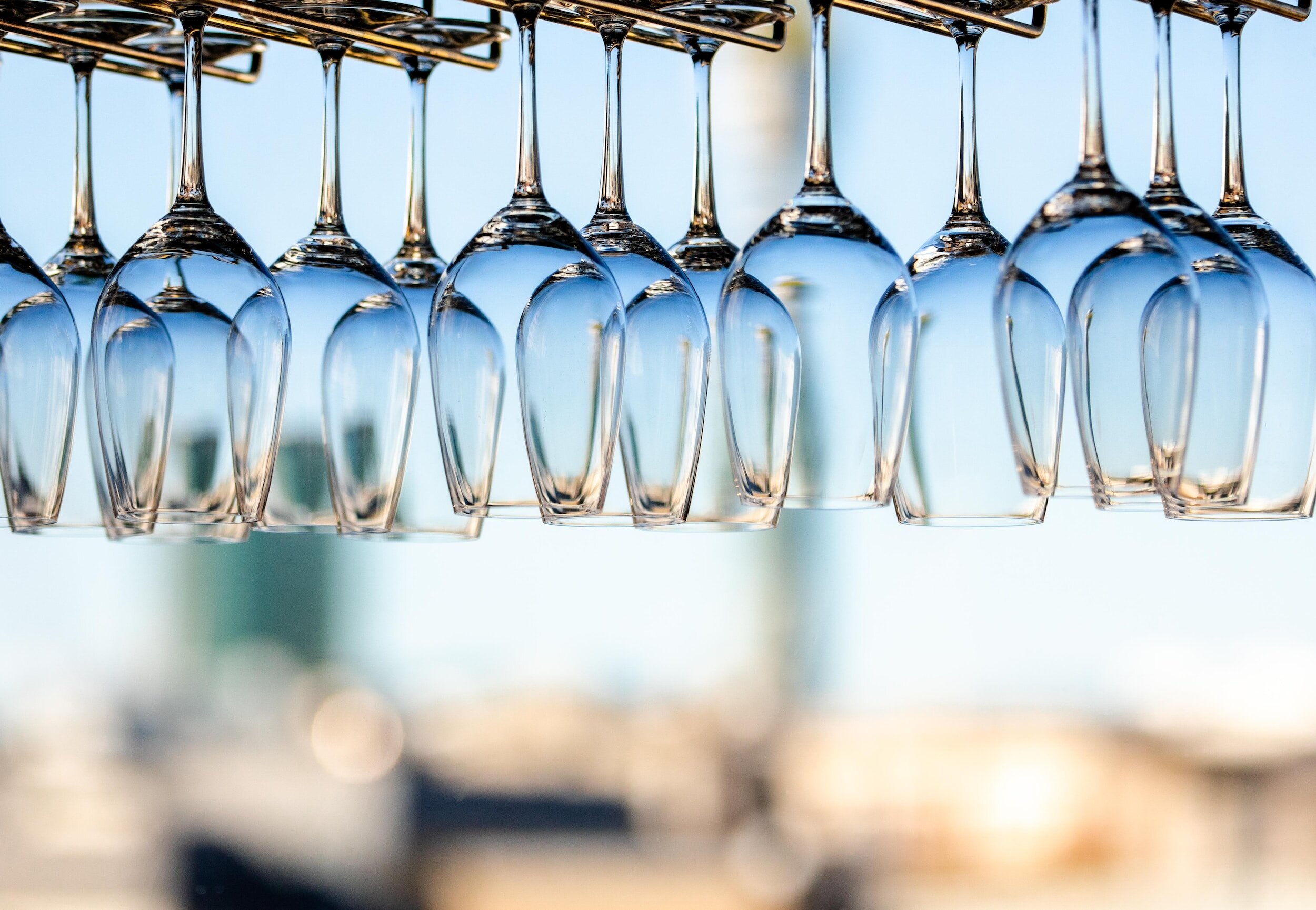
If you enjoy red wines with bright red fruit and a savory quality, then Tempranillo is the better wine for you. If you love lush, plush, deep red wines, then Malbec is the better choice.
Final Thoughts – Malbec or Tempranillo?
Both Tempranillo and Malbec present delightful red wine options with their own unique characteristics.
I’m a big fan of side-by-side tastings to tease out the different wine characteristics. A great way to get started with these two wines is to do a side-by-side comparison.
Grab 2 bottles of similarly priced Tempranillo and Malbec. Invite over a few friends and enjoy an evening of swirling and sipping.
Discover: Spanish red wines you need to be drinking.
Thirsty for More?
I’m a big believer in doing side-by-side tastings to boost your wine knowledge. Here’s how to host your own wine tasting for beginners.
Check out this post on Merlot vs. Pinot Noir, another popular red wine comparison, along with Shiraz vs. Malbec.
You should be able to find delicious wines at every price point. Check out this post on how to find great wines under $50.




